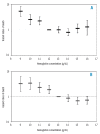Association of mild anemia with hospitalization and mortality in the elderly: the Health and Anemia population-based study
- PMID: 19001283
- PMCID: PMC2625429
- DOI: 10.3324/haematol.13449
Association of mild anemia with hospitalization and mortality in the elderly: the Health and Anemia population-based study
Abstract
Background: Mild anemia is a frequent laboratory finding in the elderly usually disregarded in everyday practice as an innocent bystander. The aim of the present population-based study was to prospectively investigate the association of mild grade anemia with hospitalization and mortality.
Design and methods: A prospective population-based study of all 65 to 84 year old residents in Biella, Italy was performed between 2003 and 2007. Data from a total of 7,536 elderly with blood tests were available to estimate mortality; full health information available to evaluate health-related outcomes was available for 4,501 of these elderly subjects. Mild grade anemia was defined as a hemoglobin concentration between 10.0 and 11.9 g/dL in women and between 10.0 and 12.9 g/dL in men.
Results: The risk of hospitalization in the 3 years following recruitment was higher among the mildly anemic elderly subjects than among subjects who were not anemic (adjusted hazard ratio: 1.32; 95% confidence interval: 1.09-1.60). Mortality risk in the following 3.5 years was also higher among the mildly anemic elderly (adjusted hazard ratio: 1.86; 95% confidence interval: 1.34-2.53). Similar results were found when slightly elevating the lower limit of normal hemoglobin concentration to 12.2 g/dL in women and to 13.2 g/dL in men. The risk of mortality was significantly increased in mild anemia of chronic disease but not in that due to beta-thalassemia minor.
Conclusions: After controlling for many potential confounders, mild grade anemia was found to be prospectively associated with clinically relevant outcomes such as increased risk of hospitalization and all-cause mortality. Whether raising hemoglobin concentrations can reduce the risks associated with mild anemia should be tested in controlled clinical trials.
Figures



Comment in
-
Prognostic implications of anemia in older adults.Haematologica. 2009 Jan;94(1):1-2. doi: 10.3324/haematol.2008.001289. Haematologica. 2009. PMID: 19118372 Free PMC article.
Similar articles
-
Prevalence of anemia in elderly patients in primary care: impact on 5-year mortality risk and differences between men and women.Curr Med Res Opin. 2009 May;25(5):1143-58. doi: 10.1185/03007990902860325. Curr Med Res Opin. 2009. PMID: 19317606
-
Prevalence, incidence and types of mild anemia in the elderly: the "Health and Anemia" population-based study.Haematologica. 2010 Nov;95(11):1849-56. doi: 10.3324/haematol.2010.023101. Epub 2010 Jun 9. Haematologica. 2010. PMID: 20534701 Free PMC article.
-
Mild anemia and 11- to 15-year mortality risk in young-old and old-old: Results from two population-based cohort studies.PLoS One. 2021 Dec 31;16(12):e0261899. doi: 10.1371/journal.pone.0261899. eCollection 2021. PLoS One. 2021. PMID: 34972180 Free PMC article.
-
Evaluation and management of anemia in the elderly.Am J Hematol. 2014 Jan;89(1):88-96. doi: 10.1002/ajh.23598. Am J Hematol. 2014. PMID: 24122955 Free PMC article. Review.
-
Anemia in the Elderly.Hemasphere. 2018 Apr 17;2(3):e40. doi: 10.1097/HS9.0000000000000040. eCollection 2018 Jun. Hemasphere. 2018. PMID: 31723768 Free PMC article. Review.
Cited by
-
Unexplained anemia in the elderly - a real life analysis of 981 patients.Arch Med Sci. 2019 Feb 5;16(4):834-841. doi: 10.5114/aoms.2019.82723. eCollection 2020. Arch Med Sci. 2019. PMID: 32542085 Free PMC article.
-
Predicting quetiapine dose in patients with depression using machine learning techniques based on real-world evidence.Ann Gen Psychiatry. 2024 Jan 6;23(1):5. doi: 10.1186/s12991-023-00483-w. Ann Gen Psychiatry. 2024. PMID: 38184628 Free PMC article.
-
Associations of the antioxidant capacity and hemoglobin levels with functional physical performance of the upper and lower body limbs.Age (Dordr). 2014 Apr;36(2):851-67. doi: 10.1007/s11357-013-9607-y. Epub 2014 Jan 3. Age (Dordr). 2014. PMID: 24385217 Free PMC article.
-
Clinical significance of somatic mutation in unexplained blood cytopenia.Blood. 2017 Jun 22;129(25):3371-3378. doi: 10.1182/blood-2017-01-763425. Epub 2017 Apr 19. Blood. 2017. PMID: 28424163 Free PMC article.
-
Anemia and mortality in older persons: does the type of anemia affect survival?Int J Hematol. 2012 Mar;95(3):248-56. doi: 10.1007/s12185-012-1007-z. Epub 2012 Feb 21. Int J Hematol. 2012. PMID: 22351246
References
-
- Salive ME, Cornoni-Huntley J, Guralnik JM, Phillips CL, Wallace RB, Ostfeld AM, et al. Anemia and hemoglobin levels in older persons: relationship with age, gender, and health status. J Am Geriatr Soc. 1992;40:489–96. - PubMed
-
- Anía BJ, Suman VJ, Fairbanks VF, Rademacher DM, Melton LJ., III Incidence of anemia in older people: an epidemiological study in a well defined population. J Am Geriatr Soc. 1997;45:825–31. - PubMed
-
- Guralnik JM, Eisenstaedt RS, Ferrucci L, Klein HG, Woodman RC. Prevalence of anemia in persons 65 years and older in the United States: evidence for a high rate of unexplained anemia. Blood. 2004;104:2263–8. - PubMed
-
- Carmel R. Anemia and aging: an overview of clinical, diagnostic and biological issues. Blood Rev. 2001;15:9–18. - PubMed
-
- Nissenson AR, Goodnough LT. Anemia. Not just an innocent bystander? Arch Intern Med. 2003;163:1400–4. - PubMed
Publication types
MeSH terms
LinkOut - more resources
Full Text Sources
Medical

